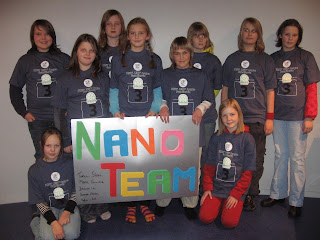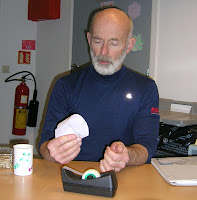
Today the 22nd of April is Earth Day, and has been so since 1970, when it was initiated by
Gaylord Nelson, a United States Senator from Wisconsin. (Not to be cunfused with the United Nations Earth Day, celebrated each year on the vernal (March) equinox.) According to Wikipedia April 22nd is celebrated by 500 million people in 175 countries. I must admit, I had not heard of the day until today. Reading the news of a Norwegian newspaper, I became aware of the way Google celebrated the day. Their logo today is a sinking iceberg, and by clicking the logo you get a list of hits as if you had seached for "Earth Day". Top ranked is the
Earth Day Network, a nonprofit organisation coordinating the events worldwide. They use the slogan " A call for Action on Climate Change", and ask you to get involved in different ways. One is
Project Switch, asking you to save energy by changing your inefficient light bulbs. They are also asking people to be
Carbon Neutral, by "Reduce what you can, offset what you can't".
Carbon neutrality is a hot topic in Norway. Because of our oil production, we are one of the countries exceeding our emissions of carbon dioxide as decided by the
Kyoto-protocol. This is something we are not willing to accept anymore, with Gro Harlem Brundtland as one of our former Prime Ministers we wish to aim higher. Brundtland was Chair of the World Commission on Environment and Development (WCED), referred to as the
Brundtland Commission, developing the political concept of
sustainable development and published its report
Our Common Future in April 1987.
After releasing the
4th Assessment Report by the
Intergovernmental Panel on Climate Change in February, the awareness of the consequences we are facing has hit the ceiling. Everyone is talking about it here in Norway. Even our Prime Minister Jens Stoltenberg. A few days back he proclaimed that Norway would reduce the emission of carbon by 30 % by the year 2020 and become carbon neutral (100 %) by the year 2050. The last goal seem like a fairytale, but I am proud that we have a government that finally has understood the importance of action to save our planet as we know it.

The Chairman of the 4th Assessment Report, Dr Rajendra K. Pachauri, is coming to Tromsø June 5th, which is the United Nations
World Enviroment Day. Tromsø is hosting the main celebrations of the day, which is commemorated each year on this date. This year the agenda is "
Melting Ice - a hot topic?". In Tromsø there will be a conference and many other events focusing on the topic. The Science Center is going to participate, teaching children about ice the whole "Environment Week".
Wherever you are, you should celebrate the day. The topic is to important to leave unnoticed. UN are suggesting
77 ways of celebrating June 5th, by the World Environment Day Alphabet. And at the Science Center we know of more ways to do it. If you are interested in teaching this at your school, sharing this with your kids or just try it for yourself, don't hesitate to contact me.
 Technology and design is a new topic in the school curriculum here in Norway. At the Science Center we have a toy construction activity for the mid-level classes called Speedmonster. The activity is designed by Elisabeth Kanebog and Marte Karidatter Skadsem, as a collaboration between "Den kulturelle skolesekken" and the Science Center. Elisabeth is an art teacher excelling in design and the design process and Marte is our tech expert in the house. Speedmonster is partially based upon old mechanical toys and the activity is divided in three parts;
Technology and design is a new topic in the school curriculum here in Norway. At the Science Center we have a toy construction activity for the mid-level classes called Speedmonster. The activity is designed by Elisabeth Kanebog and Marte Karidatter Skadsem, as a collaboration between "Den kulturelle skolesekken" and the Science Center. Elisabeth is an art teacher excelling in design and the design process and Marte is our tech expert in the house. Speedmonster is partially based upon old mechanical toys and the activity is divided in three parts; Cut away excess clay and make sure you have a thicker layer of clay on the sides, to fit the two screws placed on each side underneath the shell, before the shell is baked in an oven. The shell will crack if you try to screw the screws into the clay after it has hardened in the oven.
Cut away excess clay and make sure you have a thicker layer of clay on the sides, to fit the two screws placed on each side underneath the shell, before the shell is baked in an oven. The shell will crack if you try to screw the screws into the clay after it has hardened in the oven.
 The Chairman of the 4th Assessment Report, Dr Rajendra K. Pachauri, is coming to Tromsø June 5th, which is the United Nations
The Chairman of the 4th Assessment Report, Dr Rajendra K. Pachauri, is coming to Tromsø June 5th, which is the United Nations 








